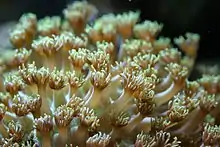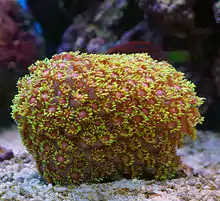Goniopora
Goniopora, often called flowerpot coral, is a genus of colonial stony coral found in lagoons and turbid water conditions. Goniopora have numerous daisy-like polyps that extend outward from the base, each tipped with 24 stinging tentacles which surrounds a mouth.
| Goniopora | |
|---|---|
 | |
| Scientific classification | |
| Kingdom: | Animalia |
| Phylum: | Cnidaria |
| Class: | Anthozoa |
| Order: | Scleractinia |
| Family: | Poritidae |
| Genus: | Goniopora Blainville, 1830[1] |
| Synonyms | |
|
List
| |

Distribution
Species of Goniopora can be found in the Persian Sea areas, the Indian Ocean, and various tropical and subtropical areas of the Pacific Ocean. Various species live as far north as Hong Kong (where they are the dominant colonial non-reef-building coral) and southern Japan.
Care
Goniopora is a sensitive coral that when probed can sensitise and contract . Goniopora are a very difficult coral to keep alive and are not recommended for a novice reef aquarium hobbyist. The short, greenish-colored species are less sturdy and durable than the pink or purple species.[2] Many precautions must be taken to raise Goniopora. First, they require moderate to high lighting, depending on species. They must also have some water movement so their polyps can move freely. However, it should not be directed right at the polyps or the movement might be too vigorous. The water temperature must remain between 77 and 84 °F (25 and 29 °C). There must be adequate amounts of calcium and iron in the tank to help skeletal development. Placement in the tank is also crucial. They must be well positioned on a sturdy rock to avoid damaging falls. When placing Goniopora they must have enough room to grow and move their tentacles. Goniopora should be monitored for shriveling after being moved to a new tank to make sure they are getting enough sunlight.
Feeding
Goniopora are avid feeders susceptible to death from nutritional deficiencies. There are many different ways to feed Goniopora. For example, they can be directly fed with a syringe (avoiding a hard, straight flow into the polyps or that triggers them to close up) or food can be sprinkled on the top of the tank and let to reach the Goniopora on its own. However, direct feeding seems to work best. Alternately, plankton can be placed in the tank with all filtration systems off so the food does not get swept away. The filters should be turned back on after one to two hours to keep the tank clean and livable for all of the creatures. Goniopora need foods high in manganese and iron.[3]
Fragging
Goniopora grow daughter cells in a type of asexual reproduction called fragging. The mother corals have wounds from the daughter corals that usually heal up in about two weeks. The daughter corals grow about 1 millimeter a month. Some scientists suggest that the daughter Goniopora live inside cells of the mother coral before breaking out and growing on their own
Issues
There are many issues that go along with keeping Goniopora. The first one is that it is very hard to locate and buy, especially the red species. Goniopora may grow in murky or clear water depending on the species. Because different species have such different requirements, it adds to the challenge of keeping them alive.
Species
This genus contains the following species:[4]
- Goniopora albiconus Veron, 2002
- Goniopora burgosi Nemenzo, 1955
- Goniopora calicularis (Lamarck, 1816)
- Goniopora cellulosa Veron, 1990
- Goniopora ciliatus Veron, 2002
- Goniopora columna Dana, 1846
- Goniopora diminuta (Veron, 2000)
- Goniopora djiboutiensis Vaughan, 1907
- Goniopora eclipsensis Veron & Pichon, 1982
- Goniopora fruticosa Saville-Kent, 1891
- Goniopora granulosa Pillai & Scheer, 1976
- Goniopora lobata Milne Edwards & Haime
- Goniopora norfolkensis Veron & Pichon, 1982
- Goniopora paliformis (Veron, 2000)
- Goniopora palmensis Veron & Pichon, 1982
- Goniopora pandoraensis Veron & Pichon, 1982
- Goniopora pearsoni Veron, 2002
- Goniopora pedunculata Quoy & Gaimard, 1833
- Goniopora pendulus Veron, 1985
- Goniopora petiolata Nemenzo, 1955
- Goniopora planulata (Ehrenberg)
- Goniopora polyformis Zou, 1980
- Goniopora savignyi (Dana)
- Goniopora somaliensis Vaughan, 1907
- Goniopora stokesi Milne Edwards & Haime, 1851
- Goniopora sultani Veron, DeVantier & Turak, 2002
- Goniopora tantillus (Claereboudt & Al Amri, 2004)
- Goniopora tenella (Quelch)
- Goniopora tenuidens Quelch
References
- WoRMS (2018). "Goniopora de Blainville, 1830". WoRMS. World Register of Marine Species. Retrieved 2018-08-21.
- http://reefcorner.com/reef-database-index/large-polyp-stony-coral-index/purple-goniopora-coral/
- "HugeDomains.com - ReefPeDia.com is for sale (Reef Pe Dia)". www.reefpedia.com. Cite uses generic title (help)
- "WoRMS - World Register of Marine Species - Goniopora de Blainville, 1830". www.marinespecies.org.